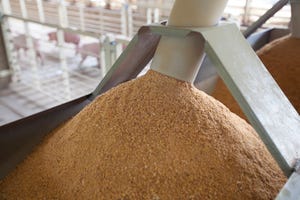April 15, 2013

While Corn Belt crop producers look back at USDA’s March 28 reports and wonder “what happened here,” livestock feeders are doing “high-fives” with themselves. Although the acreage projection was not unexpected, it forecast the potential for increased production and subsequently lower prices for feedgrains and soybean meal in the next marketing year, says blogger Stu Ellis at http://www.farmgateblog.com.
However, the quarterly grain stocks report contained surprises to the market that pushed prices down for the old crop and immediately lowered the cost of feed for livestock producers. Not a bad way to begin the spring if you have a lot of mouths to feed.
USDA’s Feed Outlook is chock full of good news for livestock feeders, based on the increased availability of feed and lower prices. However, some spot shortages have raised cash prices and what has dropped on the futures market has been negated by an increased basis.
Nevertheless, livestock producers foresee opportunities for profitability that were dimmed before the USDA’s two reports on March 28. Livestock economists are now pointing to black in the near future.
The improved opportunities for the livestock producer can be traced directly to the grain stocks report that indicated nearly 400 million more bushels of corn existed—and should be available—for the market. Evenly split between on-farm and commercial storage, unpriced U.S. corn stocks dropped $1 in value. However, finding deliverable supplies may be a challenge since the 2.7 billion bushels of corn held on farms was only 49% of the total supply, and at this point in the marketing year, farmers typically hold closer to 60% of the crop.
In feed terms, USDA says the projected supply of feedgrains is 319 million metric tons (mmt). While that is 11% below the 358 mmt of 2012, higher sorghum and barley imports have added to the supply. And feed use has been declining for three consecutive years, which has not occurred for 35 years. One metric ton is equal to 1.1 short (U.S.) tons.
Competitors
In competition with livestock feeders for short corn supplies is the ethanol industry, which is projected to increase its use of corn by 50 million bushels, in large part due to lower costs of corn. Exporters will not be taking advantage of the lower corn prices, since increased production in Brazil will help supply global demand. U.S. corn prices remain above the price in Brazil and some other countries, which will tend to keep more of it for domestic use.
Due to the lower numbers of grain consuming animal units, the feed use of corn is expected to shrink in the second half of the current corn marketing year. It is expected to be about 800 million bushels less than the 10-year average and the fourth-lowest use of corn in a given second half of the marketing year since 1975.
Because of the higher stocks corn prices expected to be paid for feed were reduced by 30 cents per bushel on the low end of the USDA price range and by a dime on the top end with the mid-point for the marketing year reset to $6.90. However, at the end of the corn marketing year in August, available supplies of the old crop are expected to be down to 757 million bushels, and available supplies of the new crop will be minimal.
In 2012, early planting resulted in abundant supplies of corn in August, but the weather delays for planting the 2013 crop will push harvest back. And some farmers may be opting for soybean planting instead of corn if the planting season continues to be challenged.
Accessing Supplies
Livestock feeders may see a wider variation of supplies, depending on their location. States that were hurt by the 2012 drought had been seeing progressively higher acreages of continuous corn being planted. But those were the hardest hit by the drought and most of those farmers have indicated intentions to reduce corn acreage and plant a more weather-resistant crop rotation. Illinois farmers are planning a 5% reduction in corn acres, and across the Corn Belt, states from Iowa to Ohio are expecting drops in acreages.
However, the Great Lakes states, along with the Southern Plains, the Delta, and the Southeast are increasing corn acres by more than is being lost in the Corn Belt. The result may be earlier planting of more acres in Gulf Coast States that could have the potential to supply early corn, if it can be accessed.
Summary
Livestock feeders, who have been challenged in finding supplies and paying for them, have benefitted from increased stocks of corn and lower prices due to USDA’s reports at the end of March.
While those supplies will be tight through August, and Corn Belt weather has delayed planting, early planting has occurred in the Gulf States, which may supply needed corn in early August. Due to high prices of old corn, exports have been reduced, but the $1 drop in corn prices since the end of March has also meant increased competition for corn from the ethanol industry. The 2013 acreage will increase, but not in the Corn Belt, where many farmers will return to traditional crop rotations.
You May Also Like



